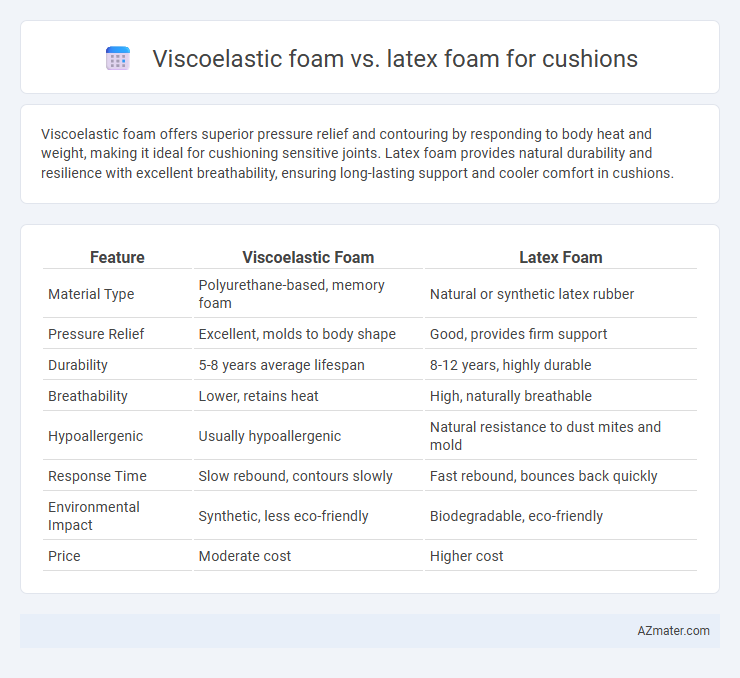Viscoelastic foam offers superior pressure relief and contouring by responding to body heat and weight, making it ideal for cushioning sensitive joints. Latex foam provides natural durability and resilience with excellent breathability, ensuring long-lasting support and cooler comfort in cushions.
Table of Comparison
| Feature | Viscoelastic Foam | Latex Foam |
|---|---|---|
| Material Type | Polyurethane-based, memory foam | Natural or synthetic latex rubber |
| Pressure Relief | Excellent, molds to body shape | Good, provides firm support |
| Durability | 5-8 years average lifespan | 8-12 years, highly durable |
| Breathability | Lower, retains heat | High, naturally breathable |
| Hypoallergenic | Usually hypoallergenic | Natural resistance to dust mites and mold |
| Response Time | Slow rebound, contours slowly | Fast rebound, bounces back quickly |
| Environmental Impact | Synthetic, less eco-friendly | Biodegradable, eco-friendly |
| Price | Moderate cost | Higher cost |
Introduction to Viscoelastic and Latex Foams
Viscoelastic foam, also known as memory foam, is a temperature-sensitive material that molds to the body by responding to heat and pressure, providing customized support and pressure relief. Latex foam, derived from natural rubber or synthetic materials, offers a resilient, breathable, and durable cushion with a bouncy feel and excellent airflow. Both foams are popular in cushions due to their unique comfort properties, with viscoelastic foam excelling in contouring and latex foam prized for its responsiveness and natural hypoallergenic features.
What is Viscoelastic Foam?
Viscoelastic foam, also known as memory foam, is a type of polyurethane foam infused with viscoelastic chemicals that enhance its density and elasticity, allowing it to conform closely to body contours and provide superior pressure relief. Unlike latex foam, which is derived from natural or synthetic rubber and offers a bouncier, more responsive surface, viscoelastic foam slowly returns to its original shape after compression, promoting customized support and reducing motion transfer. This unique characteristic makes viscoelastic foam an optimal choice for cushions designed to enhance comfort and ergonomic support.
What is Latex Foam?
Latex foam is a natural or synthetic material derived from rubber tree sap, known for its resilience, breathability, and durability in cushions. Unlike viscoelastic foam, which contours slowly under pressure, latex foam provides a responsive and buoyant support that quickly regains its shape. Its open-cell structure enhances airflow, reducing heat retention and promoting cooler comfort in seating and bedding cushions.
Comfort and Support Comparison
Viscoelastic foam, also known as memory foam, offers superior pressure relief by contouring to the body's shape, providing customized comfort and consistent support that reduces pressure points. Latex foam delivers a responsive and resilient surface with natural elasticity, promoting better airflow and maintaining firm support that prevents sinking and enhances overall durability. For cushions, viscoelastic foam excels in cradling and conforming support, while latex foam excels in bounce and long-term structural integrity.
Pressure Relief Capabilities
Viscoelastic foam offers superior pressure relief capabilities by conforming closely to body contours, distributing weight evenly, and reducing pressure points, making it ideal for individuals with joint pain or pressure sensitivity. Latex foam, while providing good support and resilience, tends to be firmer and less contouring, resulting in slightly less effective pressure relief but better responsiveness and breathability. For cushions intended to maximize comfort and minimize pressure buildup, viscoelastic foam is generally preferred due to its enhanced ability to absorb and dissipate pressure over extended periods.
Durability and Lifespan
Viscoelastic foam, known as memory foam, offers high durability with a typical lifespan of 7 to 10 years due to its ability to slowly return to its original shape and resist permanent indentations. Latex foam cushions, made from natural or synthetic rubber, generally provide superior durability, lasting 10 to 15 years, thanks to their resilience and natural resistance to sagging and microbial growth. Both materials offer long-lasting comfort, but latex foam edges out in durability and lifespan for cushion applications.
Breathability and Temperature Regulation
Viscoelastic foam, also known as memory foam, tends to retain heat due to its dense structure, resulting in lower breathability and less effective temperature regulation. In contrast, latex foam features an open-cell structure with natural ventilation, promoting superior airflow and enhanced breathability, which helps maintain a cooler sleeping surface. The temperature-neutral properties of latex foam make it a preferred choice for users seeking better climate control in cushions.
Allergen and Chemical Considerations
Viscoelastic foam, often made from polyurethane-based materials, can emit volatile organic compounds (VOCs) that may trigger allergic reactions or sensitivities in some individuals, whereas natural latex foam, derived from rubber tree sap, is generally hypoallergenic and resistant to dust mites and mold. Chemical treatments in synthetic viscoelastic foam may contain flame retardants and other additives linked to respiratory irritations, while natural latex typically uses fewer chemicals and offers better breathability. Choosing natural latex foam reduces exposure to potential allergens and harsh chemicals, making it a preferred option for those with chemical sensitivities or allergies.
Price and Value Analysis
Viscoelastic foam cushions typically range from $100 to $300, offering excellent pressure relief and contouring at a moderate price point. Latex foam cushions, priced between $200 and $500, provide superior durability and natural hypoallergenic properties, delivering long-term value despite a higher initial cost. For budget-conscious buyers, viscoelastic foam offers good comfort and affordability, while latex foam appeals to those seeking enhanced lifespan and eco-friendly benefits.
Which Foam is Better for Cushions?
Viscoelastic foam, often known as memory foam, provides superior pressure relief and conforms closely to body shape, making it ideal for cushions that require enhanced comfort and support. Latex foam offers greater durability, breathability, and natural resistance to allergens and dust mites, making it a healthier choice for long-lasting cushions. For cushions, viscoelastic foam excels in comfort and body contouring, while latex foam is better suited for those prioritizing resilience and natural materials.

Infographic: Viscoelastic foam vs Latex foam for Cushion
 azmater.com
azmater.com